Robin
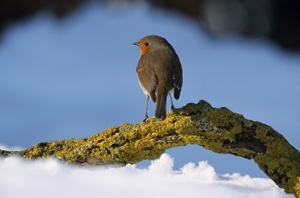 Famous for its red breast, the robin is fairly common. You will often see them dancing around the same spot in winter months when they become quite territorial and protect their patch, especially in winter months. Listen out for its song – very recognisable. You will find robins in woodlands, gardens, parks and open country. They eat spiders, beetles, worms and fruit in the summer months. Nesting from late March, they sit on their eggs for around 15 days; sometimes they will have three broods in the season.
Famous for its red breast, the robin is fairly common. You will often see them dancing around the same spot in winter months when they become quite territorial and protect their patch, especially in winter months. Listen out for its song – very recognisable. You will find robins in woodlands, gardens, parks and open country. They eat spiders, beetles, worms and fruit in the summer months. Nesting from late March, they sit on their eggs for around 15 days; sometimes they will have three broods in the season.
Photo credit: Laurie Campbell
Goldfinch
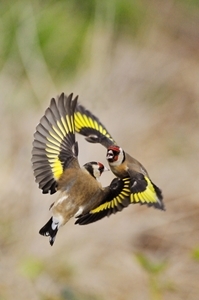 A charm of goldfinch is one of the finest sights on your bird table, with their beautiful red cheeks and yellow patches on their wings. Sociable birds, they are often seen in pairs or groups up to a thousand at a time if you are lucky. They used to be nicknamed thistle finch as they love tweaking out the seeds of a thistle with their long, pointy beaks. They will also eat small insects, including aphids. They nest on the outer twigs often in fruit trees and aim to have two broods a year, occasionally three.
A charm of goldfinch is one of the finest sights on your bird table, with their beautiful red cheeks and yellow patches on their wings. Sociable birds, they are often seen in pairs or groups up to a thousand at a time if you are lucky. They used to be nicknamed thistle finch as they love tweaking out the seeds of a thistle with their long, pointy beaks. They will also eat small insects, including aphids. They nest on the outer twigs often in fruit trees and aim to have two broods a year, occasionally three.
Photo credit: Laurie Campbell
Blue tit
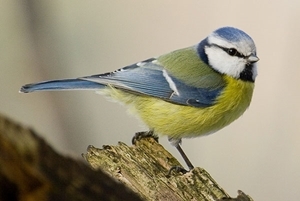 Well recognised with their blue cap, the blue tit is a much-loved garden visitor also found in deciduous woodland and farmland. They are common across the British Isles (not in Orkney and Shetland). The male is much brighter in colour with a bluer cap, and it is believed that the older the bird the bluer their cap. Blue tits don’t venture far from where they are hatched.
Well recognised with their blue cap, the blue tit is a much-loved garden visitor also found in deciduous woodland and farmland. They are common across the British Isles (not in Orkney and Shetland). The male is much brighter in colour with a bluer cap, and it is believed that the older the bird the bluer their cap. Blue tits don’t venture far from where they are hatched.
Their diet consists of seeds, insects and fruit from the beech tree. If the first clutch of eggs (usually 7-13 eggs) hatch successfully, blue tits will try to produce a second, but not if the first hatch is unsuccessful. Domestic cats have a particular interest in blue tits and are responsible for a large number of the birds not seeing out their full life.
Photo credit: Sławek Staszczuk
Wood pigeon
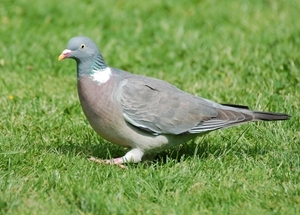 Grey with a slight hint of blue in colour, the wood pigeon is found across the country. Shy in the countryside but more confident in cities. Their cooing can be heard in woodlands and farmlands, often in the evenings. They eat seeds, berries and crops. The wood pigeon can be a real pest, raiding crops and costing farmers many millions a year in crop loss. They can be seen in small flocks but sometimes in their thousands as they move on to a crop for their next meal.
Grey with a slight hint of blue in colour, the wood pigeon is found across the country. Shy in the countryside but more confident in cities. Their cooing can be heard in woodlands and farmlands, often in the evenings. They eat seeds, berries and crops. The wood pigeon can be a real pest, raiding crops and costing farmers many millions a year in crop loss. They can be seen in small flocks but sometimes in their thousands as they move on to a crop for their next meal.
Magpie
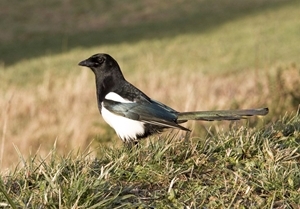 Easily recognised by its black and white colouring and its long tail, the magpie can be seen across the country. It is an omnivore, eating plants, insects, other birds including chicks, and small animals. You will often hear their unmistakable chatter. Collectively known as a parliament or mischief, they can gather in groups in the spring to dispute territory and for social gatherings.
Easily recognised by its black and white colouring and its long tail, the magpie can be seen across the country. It is an omnivore, eating plants, insects, other birds including chicks, and small animals. You will often hear their unmistakable chatter. Collectively known as a parliament or mischief, they can gather in groups in the spring to dispute territory and for social gatherings.
Magpies are managed in an attempt to protect more vulnerable species. Some songbird nests are particularly vulnerable to magpie raids.
There is a long-held tradition in the countryside to salute magpies as they pass by saying, “Good morning, Mr Magpie.” As you see magpies you might repeat this poem:
One for sorrow, two for joy;
Three for a girl, four for a boy;
Five for silver, six for gold;
Seven for a secret, never to be told;
Eight for a wish, nine for a kiss;
Ten for a bird that’s best to miss
Photo credit: David Mason
Swallow
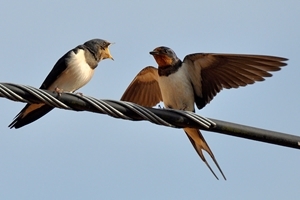 Swallows can be seen darting about our skies from spring through to autumn; it is thought to be good luck to see the first swallow returning in spring. Recognisable by its long, forked tail and white underbelly, it was believed that swallows spent the winter buried in the mud of ponds and lakes! Research then discovered that swallows undertake this enormous journey to Africa for the winter migration.
Swallows can be seen darting about our skies from spring through to autumn; it is thought to be good luck to see the first swallow returning in spring. Recognisable by its long, forked tail and white underbelly, it was believed that swallows spent the winter buried in the mud of ponds and lakes! Research then discovered that swallows undertake this enormous journey to Africa for the winter migration.
They feed on the wing, catching flying insects and giving great aerial acrobatic demonstrations for the rest of us to admire. They also swoop down low to the water’s edge to drink, but they just scoop it up and carry on with their busy lives. Both male and female swallows collect the nest material, which they pack onto open-fronted buildings near large domestic animals, e.g. cow barns. Only the female will line the nest, though.
House martin
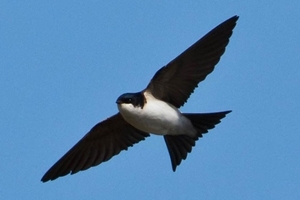 The house martin is a rounder version of the swallow, with a more distinctive white rump. They typically feed at a higher altitude than swallows but still feast on flying insects. Very sociable birds, they will nest in large colonies mostly under the eaves of houses. 1,000 beak-sized mud pellets are packed into mud cups over about ten days, and they will often reuse old nests. It is not unusual to find young from the first brood helping to feed the second brood, rarely seen in other bird species. Once the young are strong enough they join the older birds and fly south for the winter, many stopping in southern Spain while some continue to Africa.
The house martin is a rounder version of the swallow, with a more distinctive white rump. They typically feed at a higher altitude than swallows but still feast on flying insects. Very sociable birds, they will nest in large colonies mostly under the eaves of houses. 1,000 beak-sized mud pellets are packed into mud cups over about ten days, and they will often reuse old nests. It is not unusual to find young from the first brood helping to feed the second brood, rarely seen in other bird species. Once the young are strong enough they join the older birds and fly south for the winter, many stopping in southern Spain while some continue to Africa.
Photo credit: Ómar Runólfsson
Swift
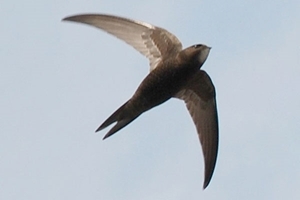 Swift return to the UK from Africa to breed. They mate for life and usually don’t breed until they are four years old – the longest-living swift ever recorded in this country was 21 years of age! They lay two or three white eggs over a period of a week or so, but incubation starts once the first egg is laid, resulting in different-aged chicks in the same nest. If insect abundance is good, all the chicks will fledge, but if weather conditions are poor and insects difficult to find, the smaller chicks may die.
Swift return to the UK from Africa to breed. They mate for life and usually don’t breed until they are four years old – the longest-living swift ever recorded in this country was 21 years of age! They lay two or three white eggs over a period of a week or so, but incubation starts once the first egg is laid, resulting in different-aged chicks in the same nest. If insect abundance is good, all the chicks will fledge, but if weather conditions are poor and insects difficult to find, the smaller chicks may die.
Swifts feed on the wing, catching tiny insects; they create a ball in their mouth and store them in a pouch, which they then feed to their young. About a week before the young swiftlets are due to leave the nest, the parents abandon them. The young have a week to grow flight feathers and trim down excess weight ready to launch out of their nests into the outside world, they have a day or two practice flying before they head south through Europe to Africa. They will sleep on the wing and sometimes not land again until they find a mate and breed, which may be in 2-4 years time.
Photo credit: Klaus Roggel
Wren
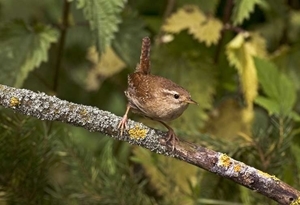 Wrens weigh the same as a £1 coin. Due to their size, at night they will huddle together for warmth; 60 individuals were once counted going into a single nest box to roost for the night. They will explore every little nook and cranny on the hunt for insects, their only source of food. In springtime, males will build up to six different domed nests for the female to chose one. She will then line this and lay up to eight white eggs, often having two broods.
Wrens weigh the same as a £1 coin. Due to their size, at night they will huddle together for warmth; 60 individuals were once counted going into a single nest box to roost for the night. They will explore every little nook and cranny on the hunt for insects, their only source of food. In springtime, males will build up to six different domed nests for the female to chose one. She will then line this and lay up to eight white eggs, often having two broods.
Photo credit: David Mason
Song thrush
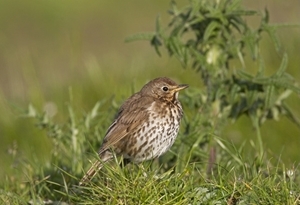 Song thrush used to be one of the most common birds seen in Britain. They sing for much of the year throughout the day, although they don’t tend to join the dawn chorus until after the blackbirds and robin have begun. They particularly like to eat soft fruit and snails. Some are migratory; unfortunately for them hunting migratory song thrush is a popular sport in southern Europe. Song thrush breed across Britain from March/April, when they will lay sky blue eggs with black speckles. They sit on their nests for 14 days with a further 14 days before the young leave their nests.
Song thrush used to be one of the most common birds seen in Britain. They sing for much of the year throughout the day, although they don’t tend to join the dawn chorus until after the blackbirds and robin have begun. They particularly like to eat soft fruit and snails. Some are migratory; unfortunately for them hunting migratory song thrush is a popular sport in southern Europe. Song thrush breed across Britain from March/April, when they will lay sky blue eggs with black speckles. They sit on their nests for 14 days with a further 14 days before the young leave their nests.
Photo credit: David Mason
Green woodpecker
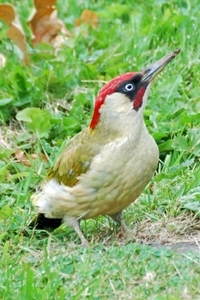 Unlike other woodpeckers, green woodpeckers spend most of their time hunting out ants and various grubs on the ground rather than in trees. They have an amazing tongue adapted to reach right into the holes; it is also coated with a sticky secretion and has a broadened tip to help it probe deep into ant nests to take adult ants and their larvae. This tongue is astonishing, as it is so long it has to coil behind the skull, over the eyes and into the right nostril in order to fit inside the bird’s head. It measures 10cm (3.9 inches), and if we had a tongue of the same relative dimensions, it would stretch out at around half a metre (1.6 feet).
Unlike other woodpeckers, green woodpeckers spend most of their time hunting out ants and various grubs on the ground rather than in trees. They have an amazing tongue adapted to reach right into the holes; it is also coated with a sticky secretion and has a broadened tip to help it probe deep into ant nests to take adult ants and their larvae. This tongue is astonishing, as it is so long it has to coil behind the skull, over the eyes and into the right nostril in order to fit inside the bird’s head. It measures 10cm (3.9 inches), and if we had a tongue of the same relative dimensions, it would stretch out at around half a metre (1.6 feet).
Have you ever wondered how woodpeckers can constantly peck away at speed without damaging their brains? Well, in a clever design, a woodpecker’s beak is separated from its skull by flexible, spongy cartilage that serves as a shock absorber.
Jay
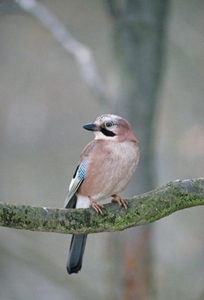 Jay have wonderful blue colouring to their wings. They mostly live in deciduous woodland but in the autumn they come out and hunt up and down hedgerows for food. They eat nuts, especially acorns, beech mast and hazel nuts. Jays are great hoarders, collecting nuts and burying them in the ground to find later during the winter when food is less plentiful. It has been estimated that a single jay could bury up to 3,000 nuts in an autumn; the chance of them finding them all again is slim and so they are helping distribute these trees and shrubs.
Jay have wonderful blue colouring to their wings. They mostly live in deciduous woodland but in the autumn they come out and hunt up and down hedgerows for food. They eat nuts, especially acorns, beech mast and hazel nuts. Jays are great hoarders, collecting nuts and burying them in the ground to find later during the winter when food is less plentiful. It has been estimated that a single jay could bury up to 3,000 nuts in an autumn; the chance of them finding them all again is slim and so they are helping distribute these trees and shrubs.
They also like to raid the nests of other birds, eating eggs and fledglings, so to help smaller nesting birds jay numbers are controlled. The jay is easily recognised by both its bright blue beautiful wing feathers and its distinctive call – they will screech when there is an intruder nearby, either human or fox.
Photo credit: Laurie Campbell